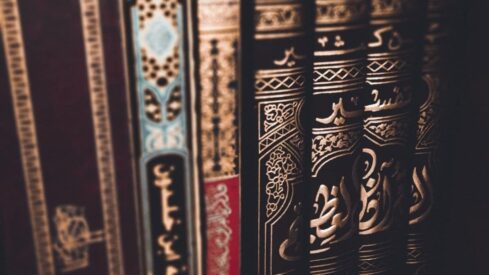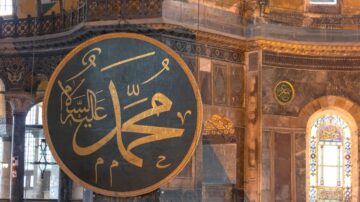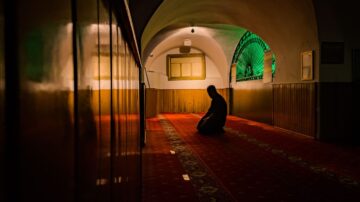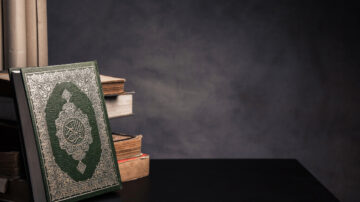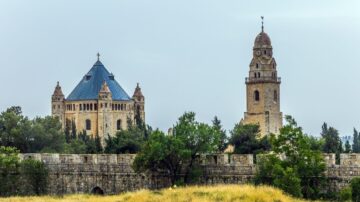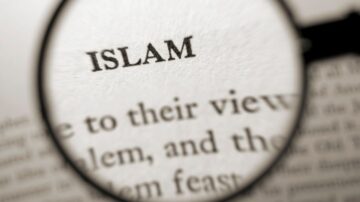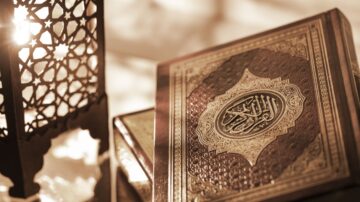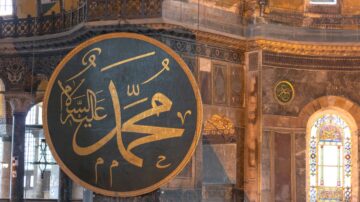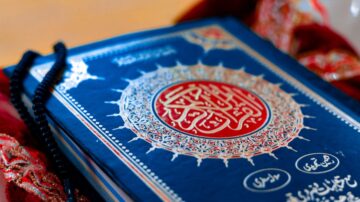Sitt Al-`Arab (d. 760/1358) had been the teacher of the well-known traditionist Al-`Iraqi (d. 742/1341), and of many others who derived a good proportion of their knowledge from her (Ibn Al-`Imad VI, 208).3 Daqiqah bint Murshid (d. 746/1345), another celebrated woman traditionist, received instruction from a whole range of other women.
Information on women traditionists of the ninth century is given in a work by Muhammad ibn `Abdur-Rahman As-Sakhawi (830–897/1427–1489), called Ad-Daw’ al-Lami`, which is a biographical dictionary of eminent persons of the ninth century.4 A further source is the Mu`jam Ash-Shuyukh of `Abdul-`Aziz ibn `Umar ibn Fahd (812–871/1409–1466), compiled in AH 861 and devoted to the biographical notices of more than 1,100 of the author’s teachers, including over 130 women scholars under whom he had studied. Some of these women were acclaimed as among the most precise and scholarly traditionists of their time, and trained many of the great scholars of the following generation.
Umm Hani Maryam (778–871/1376–1466), for instance, learned the Qur’an by heart when she was still a child, acquired all the Islamic sciences that were being taught at the time—including theology, law, history, and grammar—and then travelled to pursue Hadith with the best traditionists of her time in Cairo and Makkah. She was also celebrated for her mastery of calligraphy, her command of the Arabic language, and her natural aptitude in poetry, as also her strict observance of the duties of religion (she performed the Hajj no fewer than 13 times). Her son, who became a noted scholar of the 10th century, showed the greatest veneration for her and constantly waited on her towards the end of her life. She pursued an intensive program of learning in the great college of Cairo, giving ijazahs to many scholars. Ibn Fahd himself studied several technical works on Hadith under her (As-Sakhawi XII, no. 980).
Her Syrian contemporary, Bai Khatun (d. 864/1459), after having studied traditions with Abu Bakr Al-Mizzi and numerous other traditionalists, and having secured the ijazahs of a large number of masters of Hadith, both men and women, delivered lectures on the subject in Syria and Cairo. We are told that she took special delight in teaching (As-Sakhawi XII, no. 58).
`A’ishah bint Ibrahim (760–842/1358–1438), known in academic circles as Ibnat Ash-Sharaihi, also studied traditions in Damascus and Cairo (and elsewhere), and delivered lectures which eminent scholars of the day spared no efforts to attend (As-Sakhawi XII, no. 450). Umm Al-Khayr Saida of Makkah (d. 850/1446) received instruction in Hadith from numerous traditionists in different cities, gaining an equally enviable reputation as a scholar (As-Sakhawi XII, no. 901).
So far as may be gathered from the sources, the involvement of women in Hadith scholarship, and in the Islamic disciplines generally, seems to have declined considerably from the 10th century after Hijrah. Books such as An-Nur As-Safir of Al-`Aydarus, the Khulasat Al-Akhbar of Al-Muhibbi, and the As-Suhub Al-Wabilah of Muhammad ibn `Abdullah (which are biographical dictionaries of eminent persons of the 10th, 11th, and 12th Hijri centuries respectively) contain the names of barely a dozen eminent women traditionists. But it would be wrong to conclude from this that after the 10th century women lost interest in the subject. Some women traditionists, who gained good reputations in the 9th century, lived well into the 10th and continued their services to the Sunnah. Asma’ bint Kamal Ad-Din (d. 904/1498) wielded great influence with the sultans and their officials, to whom she often made recommendations which, we are told, they always accepted. She lectured on Hadith and trained women in various Islamic sciences (Al-`Aydarus 49).
`A’ishah bint Muhammad (d. 906/1500), who married the famous judge Muslih Ad-Din, taught traditions to many students and was appointed professor at the Salihiyah College in Damascus (Ibn Abi Tahir; see COPL, XII, no. 665ff.). Fatimah bint Yusuf of Aleppo (870–925/1465–1519) was known as one of the excellent scholars of her time (Ibn Abi Tahir, see COPL, XII, no.665ff.). Umm Al-Khayr granted an ijazah to a pilgrim at Makkah in the year 938/1531 (Goldziher II:407).
The last woman traditionist of the first rank who is known to us was Fatimah Al-Fudayliyah, also known as Ash-Shaykhah Al-Fudayliyah. She was born before the end of the 12th Hijri century and soon excelled in the art of calligraphy and the various Islamic sciences. She had a special interest in Hadith, read a good deal on the subject, received the diplomas of a good many scholars, and acquired a reputation as an important traditionist in her own right. Towards the end of her life, she settled at Makkah, where she founded a rich public library. In the Holy City she was attended by many eminent traditionists, who attended her lectures and received certificates from her. Among them, one could mention in particular sheikh `Umar Al-Hanafi and sheikh Muhammad Sali. She died in 1247/1831 (Ibn Humaid. See COPL, XII, no. 758).
Throughout the history of feminine scholarship in Islam it is clear that the women involved did not confine their study to a personal interest in traditions, or to the private coaching of a few individuals, but took their seats as students as well as teachers in pubic educational institutions, alongside their brothers in faith. The colophons of many manuscripts show them both as students attending large general classes, and also as teachers delivering regular courses of lectures. For instance, the certificate on folios 238-40 of the Al-Mashikhat ma At-Tarikh of Ibn Al-Bukhari, shows that numerous women attended a regular course of 11 lectures that was delivered before a class consisting of more than 500 students in the `Umar Mosque at Damascus in the year 687/1288. Another certificate, on folio 40 of the same manuscript, shows that many female students, whose names are specified, attended another course of six lectures on the book, which was delivered by Ibn As-Sayrafi to a class of more than 200 students at Aleppo in the year 736/1336. And on folio 250, we discover that a famous woman traditionist, Umm `Abdullah, delivered a course of five lectures on the book to a mixed class of more than 50 students at Damascus in the year 837/1433 (COPL, V/ii, 54).
*By Dr. Muhammad Zubayr Siddiqi
Sources:
Al-`Aydarus. An-Nur As-Safir.
Goldziher. Muslim Studies.
Ibn Battuta. Rihlah.
Ibn Hajar Al-`Asqalani. Ad-Durar Al-Karimah fi A`yan al-Mi’ah Ath-Thaminah.
Ibn Al-`Imad. Shadharat Adh-Dhahab fi Akhbar man Dhahab.
Ibn Khallikan. Wafayat Al-A`yan.
Ibn Salim. Al-Imdad.
Ibn Humaid, Muhammad ibn `Abdullah. As-Suhub Al-Wabilah `Ala Dara’ih Al-Hanabilah.
As-Sakhawi. Ad-Daw’ Al-Lami` li Ahl Al-Qarn At-Tasi`.
Al-`Umari. Qitf Ath-Thamar.
Yaqut. Mu`jam Al-Buldan.
Yaqut. Mu’jam Al-Udaba’.
1- Various manuscripts of this work have been preserved in libraries, and it has been published in Hyderabad in 348-50. Volume VI of Ibn Al-`Imad’s Shadharat Adh-Dhahab, a large biographical dictionary of prominent Muslim scholars from the first to the tenth centuries of the Hijrah, is largely based on this work.
2- Goldziher, accustomed to the exclusively male environment of 19th-century European universities, was taken aback by the scene depicted by Ibn Hajar. Cf. Goldziher, Muslim Studies, II, 367: “When reading the great biographical work of Ibn Hajar Al-`Asqalani on the scholars of the eighth century, we may marvel at the number of women to whom the author has to dedicate articles.”
3- We are told that Al-`Iraqi (the best known authority on the hadiths of Ghazali’s Ihya’ `Ulum Ad-Din) ensured that his son also studied under her.
4- A summary by `Abdus-Salam and `Umar ibn Ash-Shamma` exists (C. Brockelmann, Geschichte der arabischen Litteratur, second ed. (Leiden, 1943-49CE), II, 34), and a defective manuscript of the work of the latter is preserved in the O.P. Library at Patna (COPL, XII, no. 727).
5- For some particularly instructive annotated manuscripts preserved at the Zahiriya Library at Damascus, see the article of `Abd Al-`Aziz Al-Maymani in Al-Mabahith al-`Ilmiyah (Hyderabad: Da’irat Al-Ma`arif, 1358), 1-14.


